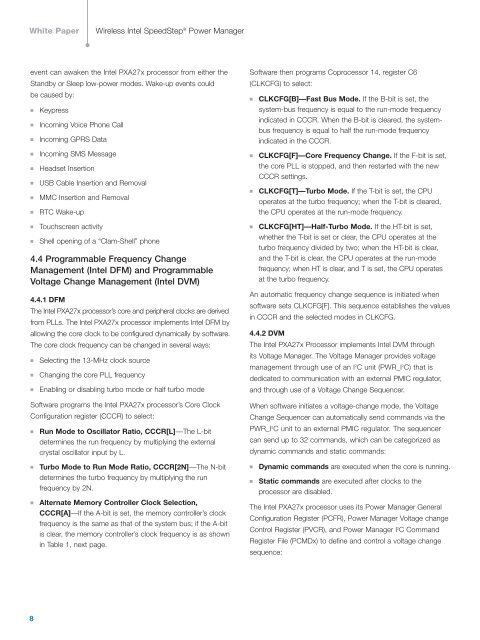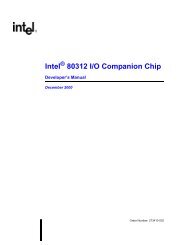Wireless Intel SpeedStep Power Manager
Wireless Intel SpeedStep Power Manager
Wireless Intel SpeedStep Power Manager
Create successful ePaper yourself
Turn your PDF publications into a flip-book with our unique Google optimized e-Paper software.
White Paper<strong>Wireless</strong> <strong>Intel</strong> <strong>SpeedStep</strong> ® <strong>Power</strong> <strong>Manager</strong>event can awaken the <strong>Intel</strong> PXA27x processor from either theStandby or Sleep low-power modes. Wake-up events couldbe caused by:■■■■■■■■■■KeypressIncoming Voice Phone CallIncoming GPRS DataIncoming SMS MessageHeadset InsertionUSB Cable Insertion and RemovalMMC Insertion and RemovalRTC Wake-upTouchscreen activityShell opening of a “Clam-Shell” phone4.4 Programmable Frequency ChangeManagement (<strong>Intel</strong> DFM) and ProgrammableVoltage Change Management (<strong>Intel</strong> DVM)4.4.1 DFMThe <strong>Intel</strong> PXA27x processor’s core and peripheral clocks are derivedfrom PLLs. The <strong>Intel</strong> PXA27x processor implements <strong>Intel</strong> DFM byallowing the core clock to be configured dynamically by software.The core clock frequency can be changed in several ways:■■■Selecting the 13-MHz clock sourceChanging the core PLL frequencyEnabling or disabling turbo mode or half turbo modeSoftware programs the <strong>Intel</strong> PXA27x processor’s Core ClockConfiguration register (CCCR) to select:■Run Mode to Oscillator Ratio, CCCR[L]—The L-bitdetermines the run frequency by multiplying the externalcrystal oscillator input by L.Software then programs Coprocessor 14, register C6(CLKCFG) to select:■■■■CLKCFG[B]—Fast Bus Mode. If the B-bit is set, thesystem-bus frequency is equal to the run-mode frequencyindicated in CCCR. When the B-bit is cleared, the systembusfrequency is equal to half the run-mode frequencyindicated in the CCCR.CLKCFG[F]—Core Frequency Change. If the F-bit is set,the core PLL is stopped, and then restarted with the newCCCR settings.CLKCFG[T]—Turbo Mode. If the T-bit is set, the CPUoperates at the turbo frequency; when the T-bit is cleared,the CPU operates at the run-mode frequency.CLKCFG[HT]—Half-Turbo Mode. If the HT-bit is set,whether the T-bit is set or clear, the CPU operates at theturbo frequency divided by two; when the HT-bit is clear,and the T-bit is clear, the CPU operates at the run-modefrequency; when HT is clear, and T is set, the CPU operatesat the turbo frequency.An automatic frequency change sequence is initiated whensoftware sets CLKCFG[F]. This sequence establishes the valuesin CCCR and the selected modes in CLKCFG.4.4.2 DVMThe <strong>Intel</strong> PXA27x Processor implements <strong>Intel</strong> DVM throughits Voltage <strong>Manager</strong>. The Voltage <strong>Manager</strong> provides voltagemanagement through use of an I 2 C unit (PWR_I 2 C) that isdedicated to communication with an external PMIC regulator,and through use of a Voltage Change Sequencer.When software initiates a voltage-change mode, the VoltageChange Sequencer can automatically send commands via thePWR_I 2 C unit to an external PMIC regulator. The sequencercan send up to 32 commands, which can be categorized asdynamic commands and static commands:■■Turbo Mode to Run Mode Ratio, CCCR[2N]—The N-bitdetermines the turbo frequency by multiplying the runfrequency by 2N.Alternate Memory Controller Clock Selection,CCCR[A]—If the A-bit is set, the memory controller’s clockfrequency is the same as that of the system bus; if the A-bitis clear, the memory controller’s clock frequency is as shownin Table 1, next page.■■Dynamic commands are executed when the core is running.Static commands are executed after clocks to theprocessor are disabled.The <strong>Intel</strong> PXA27x processor uses its <strong>Power</strong> <strong>Manager</strong> GeneralConfiguration Register (PCFR), <strong>Power</strong> <strong>Manager</strong> Voltage changeControl Register (PVCR), and <strong>Power</strong> <strong>Manager</strong> I 2 C CommandRegister File (PCMDx) to define and control a voltage changesequence:8
















